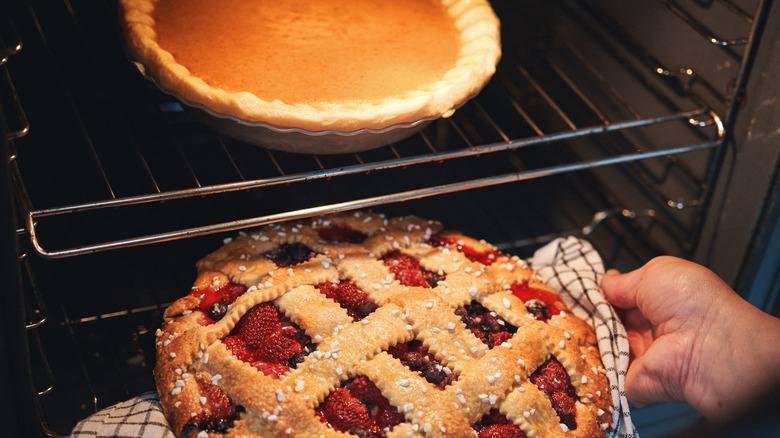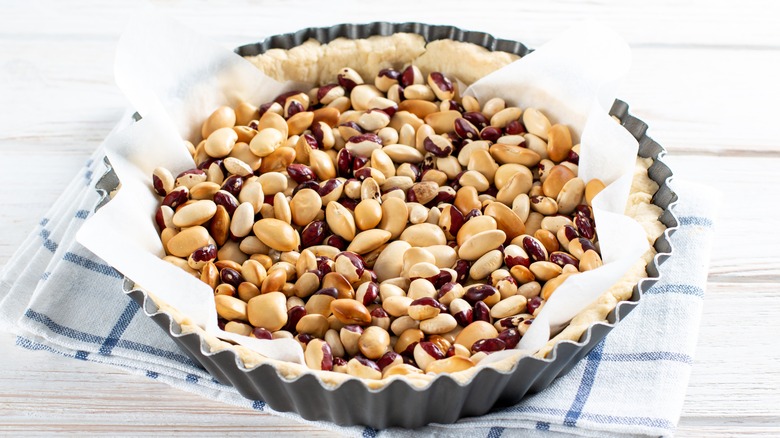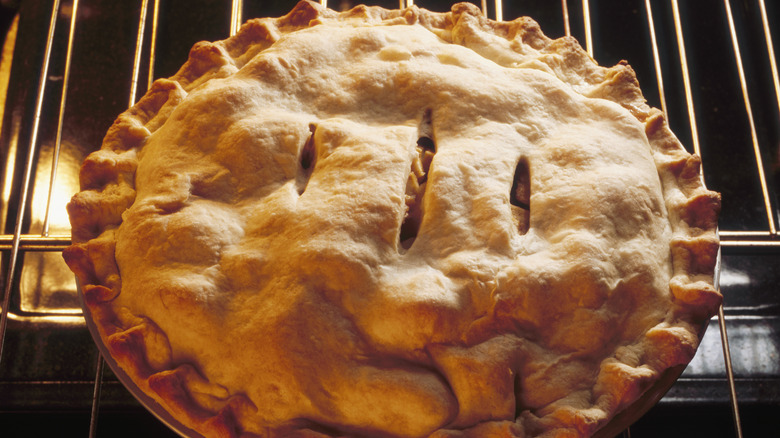Blind Vs 3-Stage Baking: What's The Difference?
Pie baking is a fundamental practice for any home baker to master. While it might seem simple to just add your pie filling of choice into a crust and toss it in the oven for a short slumber, it'll actually take a little more work to ensure you come out with the proper bake. Otherwise, you could be left with a soggy crust — the stuff of a baker's nightmares.
There are two fundamental methods you can use to give your pie the perfect color and crispness. The first is a blind bake, which refers to the process of putting your pie crust into the oven with some sort of weight, usually pie weights or dried beans, and allowing the crust to bake until it's firm. And then there's the three-stage bake, which refers instead to cooking the crust at a high heat before incrementally bringing the temperature down and then back up again to give it the perfect, golden brown hue and fully-cooked interior. While both of these methods have their merits, there are some significant differences that set them apart.
Blind baking only involves the crust
The primary difference between blind baking and three-stage baking is that blind baking focuses only on the crust — with no fillings involved. First you'll place your rolled pie crust into your pie tin and prick it with a fork to prevent it from rising upwards with steam. Then, to further ensure that the crust is weighed down, you'll fill it with parchment paper and weights before putting it in the oven. Once your crust has reached your desired degree of doneness, you can remove the weights, add your filling, and return it back to the oven to finish off the bake and set your filling.
The theory behind the blind bake is that it gives your crust a head start so it can crisp up before your wet fillings are added. This is essential for custard-filled pies, such as pecan pie or pumpkin pie, because the filling doesn't need the blast of heat from the oven to set. If you neglect to blind bake your crust for either of these pies, you'll risk a dreaded soggy bottom. Another instance where blind baking can be utilized is for a pie filling that doesn't have to be baked at all, like a Kool-Aid pie. These pies are all single-layered, as the blind bake is only used to cook that bottom crust, rather than a lattice or top crust.
It's important to note that there's a difference between par-baking and blind baking. A par-baked pie crust is cooked for less time than a completely blind baked pie. As a result, you'll hear "blind bake" more often associated with pies that don't need to be returned to the oven after the blind bake is completed.
Three-stage baking gets the fillings involved
While blind baking is often reserved for custard or no-bake single-layer pies, the three-stage baking method is fair game for a wider variety of pies, including those filled with fruit, meat, and more. The three-stage method starts with a high cook temperature, potentially upwards of 450 degrees Fahrenheit — and everything is put in the oven at the same time: pie crust, filling, and top crust or lattice. The initial high temperature gives the crust an opportunity to brown and will prevent it from getting soggy. Next, the temperature is dropped down so the fillings can cook effectively, then the temperature is brought back up again so it can lend some color to the top crust.
The three-stage baking method is great for when you're working with a crust and a filling that each need to be cooked at different temperatures. While a blind bake only focuses on hardening the pie shell, this three-stage method cooks the entire pie in one shot. That said, you also have the opportunity to go through the first two stages of pie baking one day, then pop your pie in the oven for 10 minutes to get some color on the day you're planning to serve it.


